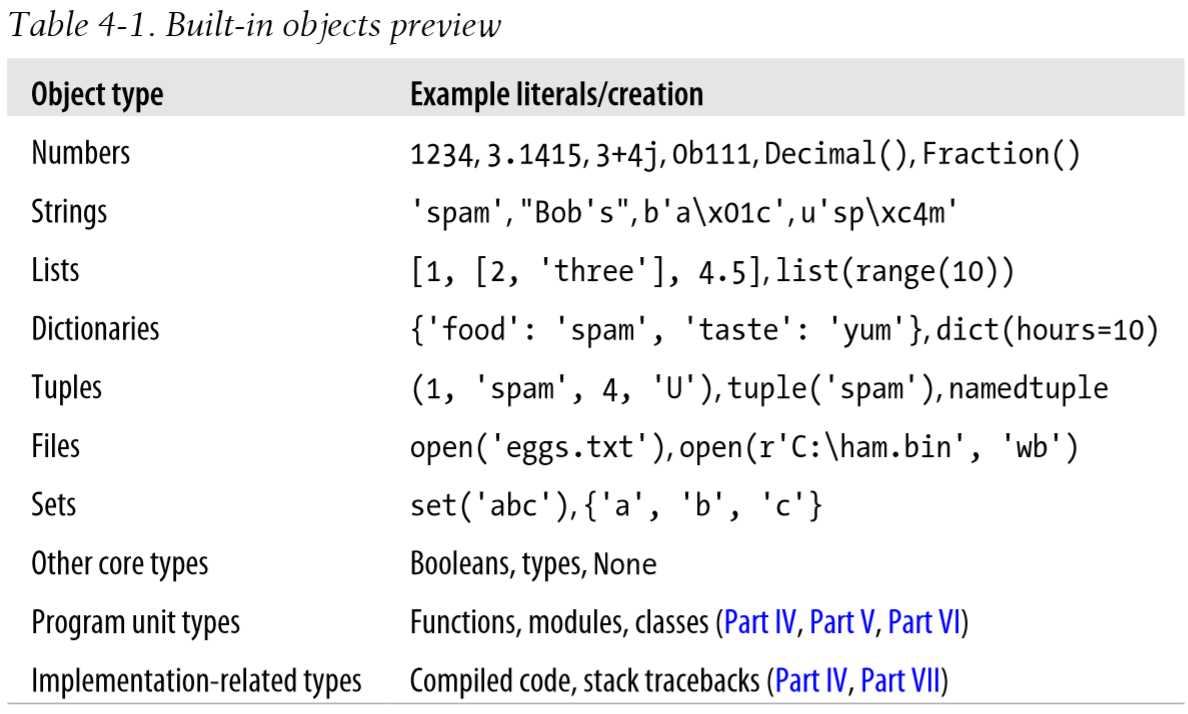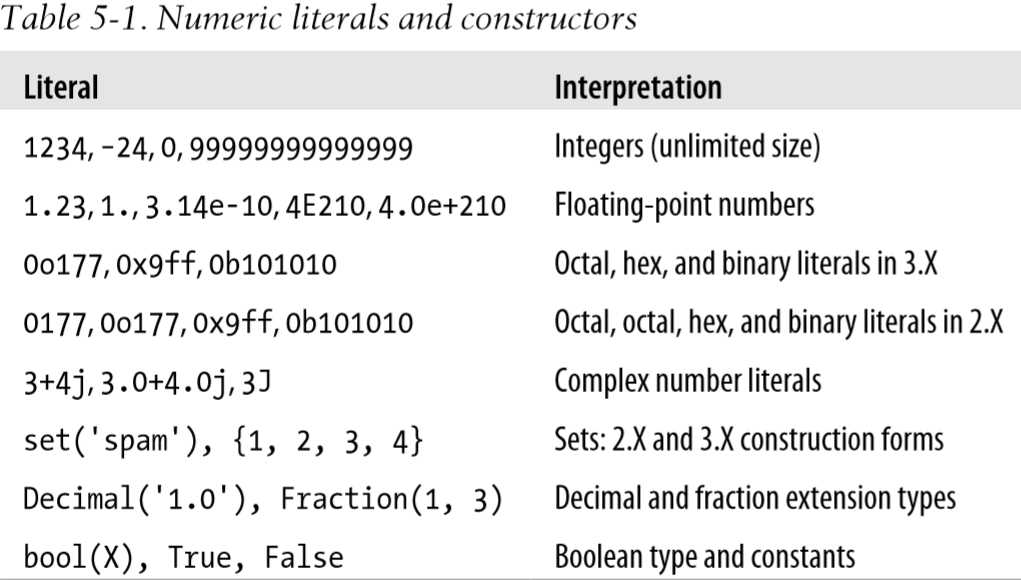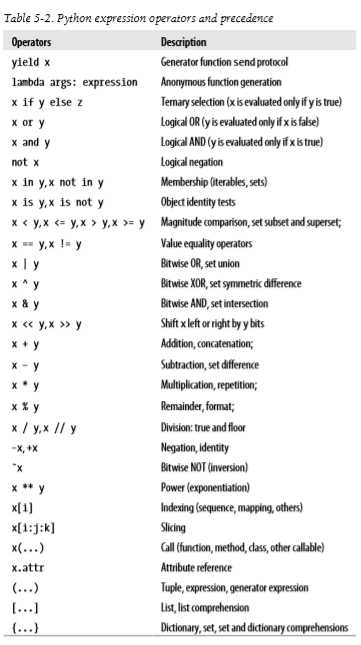标签:orm nts trunc 获得 simple statement res RoCE base
在非正式的意义上, 在 Python 中, 我们用一些东西做事情.
从更正式的角度来看,在 Python 中,数据以对象的形式出现。
As we’ll see, everything is an object in a Python script. Even simple numbers qualify, with values (e.g., 99), and supported operations (addition, subtraction, and so on).

在正式术语中, 这意味着 Python 是动态类型的, 它会自动跟踪类型, 而不是要求声明代码, 但它也是强类型的, 这意味着您可以在仅对象操作上执行对其j进行适合该类型的有效操作。
在 Python 中的每一个对象都可以分为不可变性和可变性。比如数字、字符串、元组是不可变的。不可变的:在创建后不能就地改变。
多态意味着一个操作符 (如 +) 的意义取决于被操作的对象。这将是 Python 的关键思想:不要将代码限制在特定的类型上,使代码自动适用于多种类型。
In Python, numbers are not really a single object type, but a category of similar types.
完整的 Python 数值类型清单:
| 英文 | 中文 |
|---|---|
| Integer and floating-point objects | 整数和浮点数 |
| Complex number objects | 复数 |
| Decimal: fixed-precision objects | 固定精度的十进制数 |
| Fraction: rational number objects | 有理分数 |
| Sets: collections with numeric operations | 具有数值运算的集合 |
| Booleans: true and false | 布尔类型 |
Built-in functions and modules: round, math, random, etc. |
数值相关的内建函数和模块 |
| Expressions; unlimited integer precision; bitwise operations; hex, octal, and binary formats | 表达式; 无穷的整数精度; 按位运算; 16 进制; 8 进制; 2 进制 |
| Third-party extensions: vectors, libraries, visualization, plotting, etc. | 第三方扩展 |

Integers may be coded in decimal (base 10), hexadecimal (base 16), octal (base 8), or binary (base 2), the last three of which are common in some programming domains. Hexadecimals start with a leading
0xor0X, followed by a string of hexadecimal digits (\(0\sim 9\) and \(A\sim F\)). Hex digits may be coded in lower- or uppercase. Octal literals start with a leading0oor0O(zero and lower- or uppercase lettero), followed by a string of digits (\(0\sim 7\)). In 2.X, octal literals can also be coded with just a leading0, but not in 3.X—this original octal form is too easily confused with decimal, and is replaced by the new0oformat, which can also be used in 2.X as of 2.6. Binary literals, new as of 2.6 and 3.0, begin with a leading0bor0B, followed by binary digits (\(0\sim 1\)).

请注意,在 Python 3.X 中 // (floor, 向下取整) 运算: 如果是浮点型, 则结果为浮点型;否则, 它是一个整数。下面展示一些 Floor 除法和截断除法的运算:
20 // 3620. // 36.0from math import floor, truncfloor(2.5)2floor(-2.5)-3trunc(2.5)2trunc(-2.5)-25 / 2, 5 / -2(2.5, -2.5)5 // 2, 5 // -2(2, -3)5 / 2., 5 / -2.(2.5, -2.5)5 // 2., 5 // -2.(2.0, -3.0)trunc(5 / -2)-20o1, 0o20, 0o377 # 八进制(1, 16, 255)0x01, 0x10, 0xFF # 十六进制(1, 16, 255)0b1, 0b10000, 0b11111111 # 二进制(1, 16, 255)oct(64), hex(64), bin(64)(‘0o100‘, ‘0x40‘, ‘0b1000000‘)int 会将一个数字的字符串变换为一个整数,并且通过第二个参数来确定变换后的数字进制:
int(‘64‘), int(‘100‘, 8), int(‘40‘, 16), int(‘1000000‘, 2)(64, 64, 64, 64)int(‘0x40‘, 16), int(‘0b1000000‘, 2)(64, 64)eval(‘64‘), eval(‘0o100‘), eval(‘0x40‘), eval(‘0b1000000‘)(64, 64, 64, 64)‘{0:0}, {1:x}, {2:b}‘.format(64, 64, 64)‘64, 40, 1000000‘‘%o, %x, %X‘ % (64, 255, 255)‘100, ff, FF‘x = 1
x << 2 # Shift left 2 bits4x | 2 # Bitwise OR3x & 1 # Bitwise AND1X = 99bin(X), X.bit_length() # `X.bit_length()` 获得二进制字符串的长度(‘0b1100011‘, 7)round(1/3, 7)0.3333333使用分数和小数可以避免精度的损失!
from decimal import Decimal, getcontextDecimal(0.1)Decimal(‘0.1000000000000000055511151231257827021181583404541015625‘)Decimal.from_float(1.25)Decimal(‘1.25‘)Decimal(1) / Decimal(7)Decimal(‘0.1428571428571428571428571429‘)getcontext().prec28getcontext().prec = 4 # 改变全局精度Decimal(1) / Decimal(7)Decimal(‘0.1429‘)from fractions import Fractionx = Fraction(1, 3)
xFraction(1, 3)y = Fraction(4, 6)
yFraction(2, 3)x + yFraction(1, 1)x - yFraction(-1, 3)x * yFraction(2, 9)Fraction(‘.25‘)Fraction(1, 4)Fraction(‘1.25‘)Fraction(5, 4)Fraction(‘.25‘) + Fraction(‘1.25‘)Fraction(3, 2)分数还有一个 from_float 方法,并且接受一个 Fraction 作为参数。
(2.5).as_integer_ratio()(5, 2)f = 2.5
z = Fraction(*f.as_integer_ratio())
zFraction(5, 2)xFraction(1, 3)float(x)0.3333333333333333Fraction.from_float(1.75)Fraction(7, 4)a = x + Fraction(*(4.0/3).as_integer_ratio())
aFraction(22517998136852479, 13510798882111488)a.limit_denominator(10) # 取近似Fraction(5, 3)标签:orm nts trunc 获得 simple statement res RoCE base
原文地址:https://www.cnblogs.com/q735613050/p/9833198.html